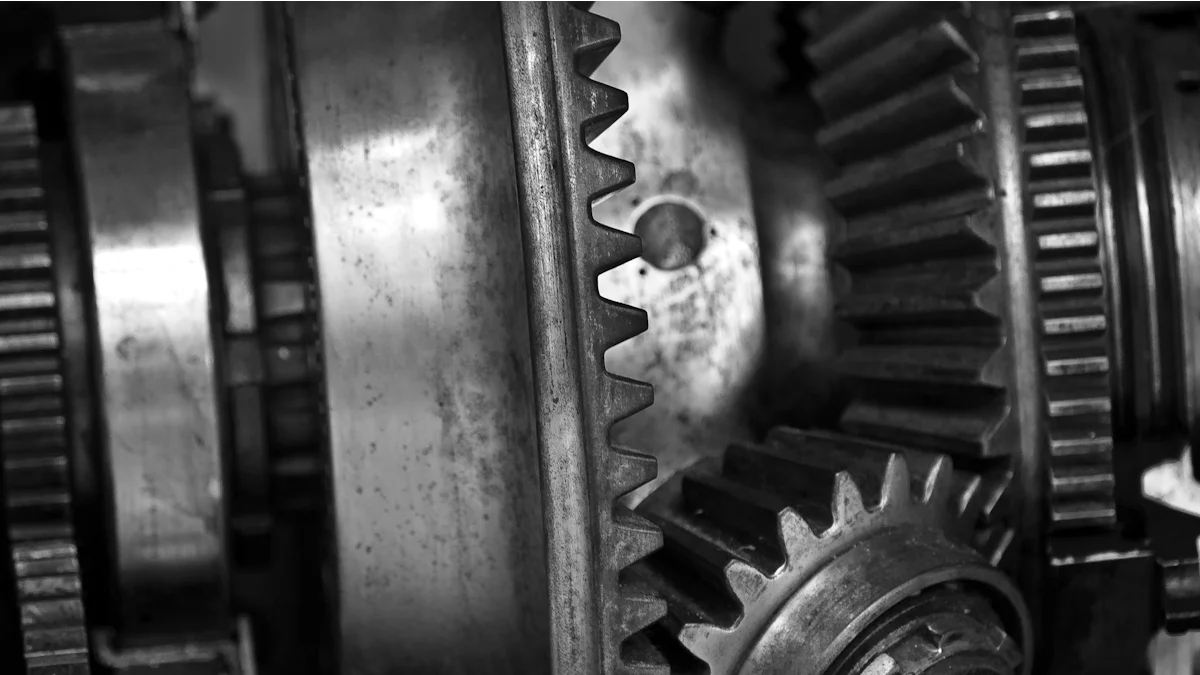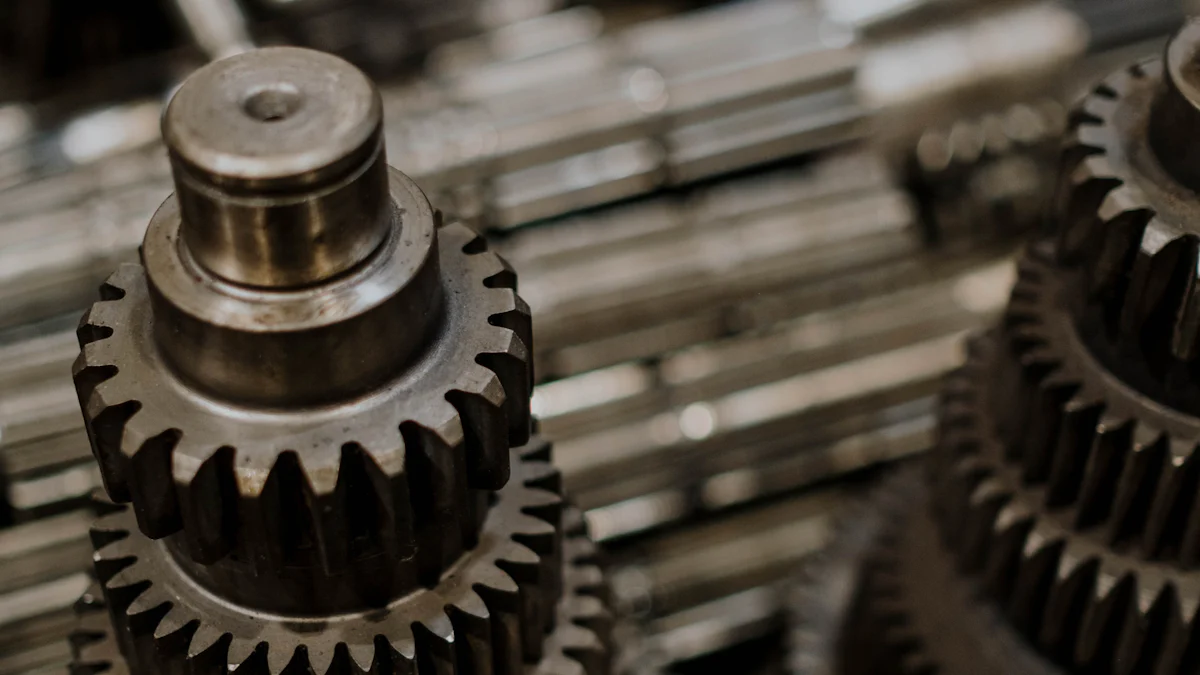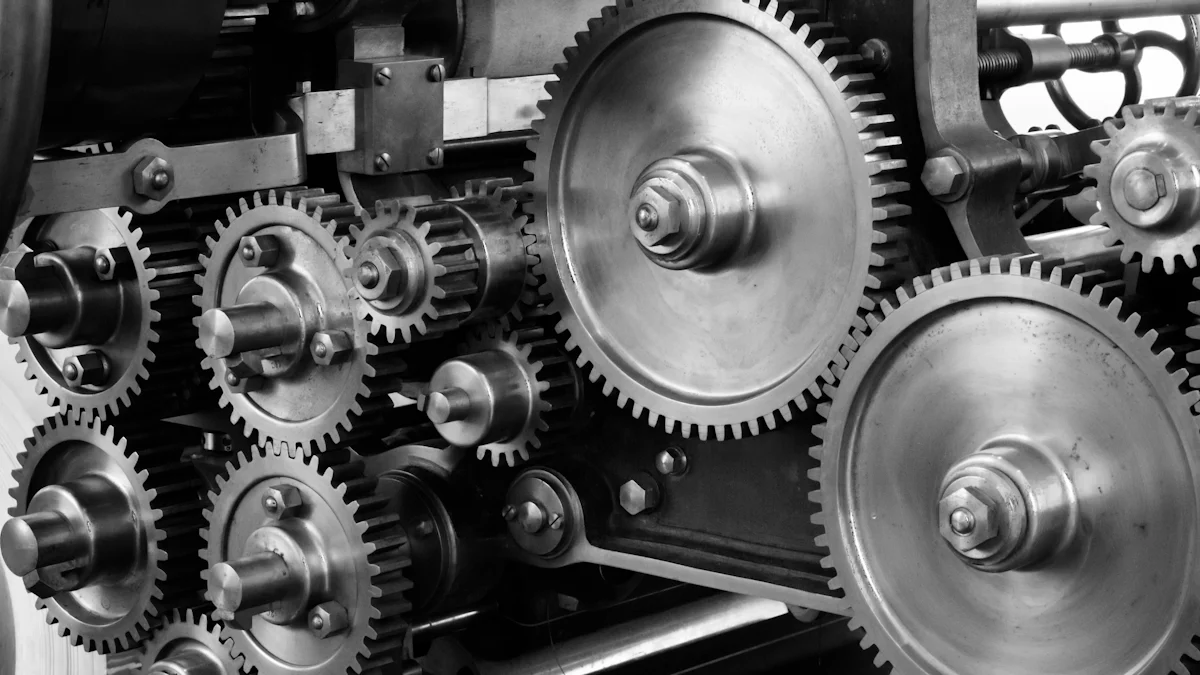
Proactive maintenance is essential for keeping your industrial gear box in optimal condition. It minimizes unexpected downtime, extends the equipment’s lifespan, and prevents expensive repairs. By addressing potential issues early, you ensure smooth operations and reduce risks. You need practical, actionable strategies to maintain efficiency and reliability in your machinery.
Key Takeaways
- Check your industrial gearbox often to find problems early. Use a list to stay organized and write down what you see.
- Always use the right lubricants approved by the maker. Check the lubricants often and change them when needed. This stops overheating and helps the gearbox last longer.
- Follow a clear maintenance plan with daily, weekly, and monthly tasks. Write down all maintenance work to see how it performs and spot repeated problems.
Regular Inspection of Industrial Gear Box

Regular inspections are critical for maintaining the performance and reliability of your industrial gear box. By identifying potential issues early, you can prevent costly repairs and avoid unexpected downtime.
Schedule Routine Visual Inspections
You should establish a routine for visually inspecting your industrial gear box. These inspections allow you to detect surface-level issues before they escalate. Look for signs of wear, corrosion, or physical damage on the gearbox housing. Pay close attention to seals and gaskets, as these components often show early signs of failure.
Create a checklist to ensure consistency during each inspection. Include items such as checking for unusual noises, vibrations, or misalignments. Document your findings to track changes over time. This practice helps you identify patterns and address recurring issues effectively.
Tip: Conduct visual inspections at least once a week or as recommended by the manufacturer. Frequent checks ensure you stay ahead of potential problems.
Check for Oil Leaks and Overheating Signs
Oil leaks and overheating are common indicators of problems in an industrial gear box. Inspect the area around the gearbox for oil stains or puddles. Leaks can lead to insufficient lubrication, which increases wear and tear on internal components.
Monitor the temperature of the gearbox during operation. Overheating often signals excessive friction, overloading, or inadequate lubrication. Use an infrared thermometer to measure surface temperatures accurately. If you notice abnormal heat levels, address the issue immediately to prevent further damage.
Note: Always follow safety protocols when inspecting a running gearbox. Wear protective gear and avoid direct contact with hot surfaces.
Proper Lubrication Practices

Proper lubrication is essential for the efficient operation of your industrial gear box. It reduces friction, minimizes wear, and ensures smooth performance. Neglecting lubrication can lead to overheating, component failure, and costly repairs.
Use Manufacturer-Approved Lubricants
Always use lubricants recommended by the gearbox manufacturer. These lubricants are specifically formulated to meet the performance requirements of your equipment. Using the wrong type of lubricant can compromise the efficiency of your industrial gear box and lead to premature wear.
Check the manufacturer’s manual or consult with a professional to identify the correct lubricant grade and type. Avoid mixing different lubricants, as this can cause chemical reactions that degrade their effectiveness. Store lubricants in a clean, dry environment to prevent contamination.
Tip: Keep a record of the lubricants used for each gearbox. This practice helps you maintain consistency and ensures compliance with manufacturer guidelines.
Monitor and Replace Lubricants Periodically
Lubricants degrade over time due to heat, contamination, and oxidation. Regularly monitor the condition of the lubricant in your industrial gear box. Look for changes in color, consistency, or the presence of debris, which indicate the need for replacement.
Establish a schedule for lubricant replacement based on the manufacturer’s recommendations and the operating conditions of your equipment. Use oil analysis tools to assess lubricant quality and detect potential issues early. Replacing lubricants on time prevents excessive wear and extends the lifespan of your gearbox.
Note: Dispose of used lubricants responsibly. Follow local regulations to minimize environmental impact.
Cleaning and Debris Management
Proper cleaning and debris management play a vital role in maintaining the efficiency of your industrial gear box. Dirt, dust, and debris can compromise performance and lead to premature wear. By keeping the gearbox clean, you ensure smooth operation and reduce the risk of damage.
Keep Gearbox Surfaces Free of Dirt and Dust
You should regularly clean the external surfaces of your gearbox to prevent dirt and dust buildup. Contaminants on the surface can find their way into seals and bearings, causing internal damage. Use a soft cloth or brush to remove dust and grime. For stubborn dirt, apply a mild cleaning solution that is safe for industrial equipment.
Inspect the surrounding environment for sources of contamination. If your gearbox operates in a dusty or dirty area, consider installing protective covers or enclosures. These barriers help shield the gearbox from external debris. Regular cleaning not only improves performance but also makes it easier to spot potential issues during inspections.
Tip: Avoid using high-pressure water or harsh chemicals, as these can damage seals and other sensitive components.
Inspect and Clean Magnetic Debris Collectors
Magnetic debris collectors are essential for trapping metal particles that result from normal wear and tear. You should inspect these collectors periodically to ensure they function effectively. Remove any accumulated debris and clean the magnets thoroughly. This practice prevents metal particles from circulating within the gearbox and causing further damage.
If your gearbox lacks a magnetic debris collector, consider installing one. It is a cost-effective way to protect internal components and extend the lifespan of your equipment. Regular maintenance of these collectors ensures optimal performance and reduces the risk of unexpected failures.
Note: Always follow the manufacturer’s guidelines when cleaning or replacing magnetic debris collectors.
Monitoring Operating Conditions
Monitoring the operating conditions of your industrial gear box is essential for maintaining its performance and preventing unexpected failures. By keeping track of critical parameters, you can identify potential issues early and take corrective action.
Track Gearbox Temperature and Pressure
Temperature and pressure are key indicators of your gearbox’s health. Excessive heat or abnormal pressure levels often signal underlying problems. Use temperature sensors or infrared thermometers to monitor the gearbox’s surface temperature during operation. Compare the readings to the manufacturer’s recommended range. Consistently high temperatures may indicate inadequate lubrication, excessive friction, or overloading.
Install pressure gauges to measure internal pressure levels. Sudden spikes or drops in pressure can point to seal failures or blockages in the lubrication system. Regularly calibrate these instruments to ensure accurate readings. Document the data to establish a baseline for normal operating conditions. This practice helps you detect deviations and address them promptly.
Tip: Set up automated monitoring systems for real-time alerts on temperature and pressure changes. These systems enhance efficiency and reduce manual effort.
Address Overloading and Stress Issues
Overloading and excessive stress can significantly reduce the lifespan of your gearbox. Avoid operating the equipment beyond its rated capacity. Overloading increases wear on gears and bearings, leading to premature failure. Review the manufacturer’s specifications to ensure the load remains within acceptable limits.
Inspect the gearbox for signs of stress, such as unusual noises, vibrations, or misalignments. These symptoms often indicate that the gearbox is under strain. Use load monitoring tools to measure the actual load during operation. If overloading occurs frequently, consider upgrading to a gearbox with a higher capacity.
Note: Addressing overloading issues promptly prevents long-term damage and ensures the reliability of your industrial gear box.
Ensuring Alignment and Balancing
Proper alignment and balancing are critical for the efficient operation of your industrial gearbox. Misalignment and imbalance can lead to excessive wear, vibrations, and even catastrophic failures. By addressing these issues proactively, you ensure smoother performance and extend the lifespan of your equipment.
Verify Shaft Alignment Regularly
Shaft misalignment is one of the leading causes of gearbox failure. You should inspect the alignment between the gearbox and connected machinery regularly. Misaligned shafts create unnecessary stress on bearings and gears, leading to premature wear. Use precision alignment tools, such as laser alignment systems, to achieve accurate results.
During inspections, look for signs of misalignment, such as unusual vibrations, excessive noise, or uneven wear patterns on components. If you detect any of these symptoms, realign the shafts immediately. Follow the manufacturer’s alignment specifications to ensure optimal performance.
Tip: Perform alignment checks after installing new equipment or making adjustments to existing machinery. This practice prevents alignment issues from developing over time.
Balance Rotating Components to Minimize Wear
Imbalanced rotating components can cause vibrations that damage internal parts of your gearbox. You should balance these components to reduce stress on bearings and gears. Use dynamic balancing equipment to measure and correct imbalances in real-time.
Inspect rotating parts, such as gears and shafts, for signs of wear or damage. Replace worn components promptly to maintain proper balance. Document your findings during each inspection to track changes and identify recurring issues.
Note: Balancing rotating components not only minimizes wear but also improves energy efficiency. A well-balanced system consumes less power and operates more smoothly.
By prioritizing alignment and balancing, you protect your gearbox from unnecessary strain and ensure reliable performance.
Securing Loose Components
Loose components in your industrial gearbox can lead to severe operational issues. Regularly inspecting and securing these parts ensures optimal performance and prevents costly failures.
Inspect and Tighten Bolts and Fasteners
Bolts and fasteners play a critical role in holding your gearbox together. Over time, vibrations and operational stresses can cause them to loosen. You should inspect these components frequently to ensure they remain secure. Use a torque wrench to verify that bolts are tightened to the manufacturer’s specified torque levels. This tool helps you avoid over-tightening, which can damage threads or weaken the fasteners.
Focus on high-stress areas, such as mounting points and connections between the gearbox and other machinery. These areas are more prone to loosening due to constant movement. Create a checklist to track which bolts and fasteners you’ve inspected. This practice ensures no component is overlooked.
Tip: Perform inspections after major operations or when the gearbox has been subjected to unusual loads. Early detection of loose bolts prevents long-term damage.
Address Loose Connections Immediately
Loose connections, such as couplings or electrical terminals, can disrupt the gearbox’s operation. You should address these issues as soon as they are identified. Check couplings for misalignment or wear, as these can loosen over time. Tighten or replace them as needed to maintain a secure fit.
Inspect electrical connections for signs of corrosion or looseness. Faulty connections can lead to erratic performance or even equipment failure. Use insulated tools to tighten electrical terminals safely. Document your findings and repairs to maintain a clear maintenance history.
Note: Ignoring loose connections can escalate minor issues into significant failures. Prompt action ensures reliability and safety.
Replacing Worn-Out Parts
Identify Wear and Tear on Components
Worn-out components can compromise the performance and safety of your industrial gearbox. You should inspect all parts regularly to identify signs of wear and tear. Look for visible damage such as cracks, chips, or deformation on gears, bearings, and seals. Pay attention to unusual noises or vibrations during operation, as these often indicate internal damage.
Use tools like calipers or micrometers to measure the dimensions of critical components. Compare these measurements to the manufacturer’s specifications to determine if the parts are still within acceptable limits. If you notice excessive wear, replace the affected components immediately to prevent further damage.
Tip: Keep a log of inspection results. This practice helps you track wear patterns and predict when parts will need replacement.
Use Genuine Parts for Replacements
When replacing worn-out components, always use genuine parts from the original manufacturer. These parts are designed to meet the exact specifications of your gearbox, ensuring compatibility and optimal performance. Using counterfeit or substandard parts may save money initially but often leads to premature failure and costly repairs.
Purchase replacement parts from authorized dealers or directly from the manufacturer. Verify the authenticity of the parts by checking for serial numbers or certification marks. Store spare parts in a clean, dry environment to prevent contamination or damage before installation.
Note: Investing in genuine parts protects your equipment and reduces the risk of unexpected downtime.
Implementing Vibration Analysis
Vibration analysis is a powerful tool for maintaining your industrial gearbox. It helps you detect potential issues early, reducing downtime and preventing costly failures. By monitoring vibrations, you can gain valuable insights into the health of your equipment.
Use Vibration Monitoring Tools Effectively
To get the most out of vibration analysis, you need to use the right tools. Invest in high-quality vibration monitoring equipment designed for industrial gearboxes. Portable vibration analyzers and fixed sensors are excellent options. These tools measure vibration levels and provide real-time data on the condition of your gearbox.
Place sensors on critical points, such as bearings and shafts, to capture accurate readings. Follow the manufacturer’s guidelines for sensor placement and calibration. Regularly check the sensors for proper functioning to ensure reliable data collection.
Tip: Use wireless vibration monitoring systems for continuous tracking. These systems allow you to monitor your gearbox remotely and receive alerts for abnormal vibrations.
Analyze Data to Predict Potential Failures
Interpreting vibration data is crucial for identifying potential problems. Look for patterns or spikes in vibration levels that deviate from the normal range. High-frequency vibrations often indicate issues like misalignment, imbalance, or bearing wear.
Use software tools to analyze the data and generate detailed reports. These reports help you pinpoint the root cause of the problem. Schedule maintenance or repairs based on the findings to prevent further damage.
Note: Train your team to understand vibration analysis reports. This knowledge enables them to take proactive measures and keep your gearbox running smoothly.
Training Maintenance Personnel
Properly trained personnel are essential for maintaining industrial gearboxes. By equipping your team with the right knowledge and fostering a proactive mindset, you can ensure consistent performance and reduce the risk of unexpected failures.
Educate Staff on Gearbox Maintenance Techniques
You should prioritize training your maintenance team on the specific requirements of gearbox care. Start by providing hands-on workshops that cover essential tasks such as lubrication, alignment, and vibration analysis. Use real-world scenarios to help your team understand how to identify and address common issues.
Create a library of resources, including manuals, videos, and troubleshooting guides. These materials allow your staff to reference best practices whenever needed. Encourage them to stay updated on the latest maintenance technologies and techniques by attending industry seminars or online courses.
Tip: Partner with gearbox manufacturers or certified trainers to deliver specialized training sessions. Their expertise ensures your team learns the most effective methods.
Foster a Proactive Maintenance Culture
Building a proactive maintenance culture starts with clear communication. Emphasize the importance of regular inspections and preventive measures during team meetings. Recognize and reward employees who identify potential issues early or demonstrate exceptional care in their work.
Encourage collaboration among team members by creating a shared maintenance log. This tool allows everyone to document findings, track repairs, and share insights. Use the data to identify patterns and improve your maintenance strategies.
Note: A proactive culture reduces downtime and extends the lifespan of your gearboxes. It also boosts team morale and accountability.
By investing in training and fostering a proactive mindset, you empower your team to maintain your industrial gearboxes effectively.
Developing a Maintenance Schedule
Creating a structured maintenance schedule ensures your industrial gearbox operates efficiently and avoids unexpected failures. A well-planned schedule helps you stay proactive and reduces the risk of costly downtime.
Create a Preventive Maintenance Plan
A preventive maintenance plan is essential for identifying and addressing potential issues before they escalate. Start by reviewing the manufacturer’s recommendations for maintenance intervals. Use this information to create a detailed timeline for inspections, lubrication, and part replacements.
Break down tasks into daily, weekly, monthly, and annual activities. For example:
- Daily: Monitor operating conditions like temperature and pressure.
- Weekly: Perform visual inspections for leaks or unusual noises.
- Monthly: Check lubricant levels and clean debris collectors.
- Annually: Conduct a comprehensive inspection and replace worn components.
Use digital tools or maintenance management software to organize and track your schedule. These tools send reminders for upcoming tasks and help you stay consistent.
Tip: Adjust your plan based on operating conditions. Harsh environments may require more frequent maintenance.
Document and Review Maintenance Activities
Keeping detailed records of maintenance activities ensures accountability and helps you track the gearbox’s performance over time. Use a logbook or digital system to document each task, including the date, findings, and actions taken.
Review these records regularly to identify patterns or recurring issues. For example, frequent lubricant degradation may indicate a need for improved sealing. Use this data to refine your maintenance schedule and address underlying problems.
Note: Accurate documentation supports compliance with industry standards and simplifies audits or inspections.
By developing and maintaining a robust schedule, you ensure long-term reliability and efficiency for your industrial gearbox.
Maintaining your industrial gearbox requires consistent effort and attention. By following these 10 essential tips, you reduce downtime, extend equipment life, and avoid costly repairs. Proactive maintenance ensures reliability and efficiency. Start implementing these strategies today, and consult professionals for complex issues to safeguard your operations and maximize performance.
FAQ
What are the signs of a failing industrial gearbox?
Look for unusual noises, excessive vibrations, overheating, or oil leaks. These symptoms often indicate internal damage or misalignment that requires immediate attention.
How often should you replace gearbox lubricants?
Replace lubricants based on the manufacturer’s recommendations or after detecting contamination, discoloration, or degradation. Regular oil analysis helps determine the optimal replacement interval.
Can you perform gearbox maintenance without professional help?
You can handle basic tasks like inspections, cleaning, and lubrication. For complex issues like vibration analysis or part replacements, consult a certified technician.
Tip: Always follow the manufacturer’s guidelines to avoid voiding warranties.
Post time: Feb-05-2025
